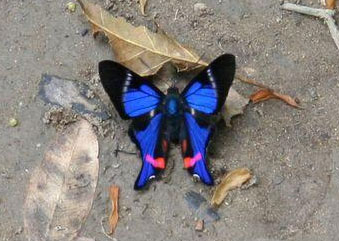Climate change is serious threat to biodiversity
Conservation International
April 11, 2006
The Earth could see massive waves of species extinctions around the world if global warming continues unabated, according to a new study published in the scientific journal Conservation Biology.
Given its potential to damage areas far away from human habitation, the study finds that global warming represents one of the most pervasive threats to our planet’s biodiversity — in some areas rivaling and even surpassing deforestation as the main threat to biodiversity.
The study expands on a much-debated 2004 paper published in the journal Nature that suggested a quarter of the world’s species would be committed to extinction by 2050 as a result of global warming. This latest study picks up where the Nature paper left off, incorporating critiques and suggestions from other scientists while increasing the global scope of the research to include diverse hotspots around the world. The results reinforce the massive species extinction risks identified in the 2004 study.
“Climate change is rapidly becoming the most serious threats to the planet’s biodiversity,” said lead author Dr. Jay Malcolm, an assistant forestry professor at the University of Toronto. “This study provides even stronger scientific evidence that global warming will result in catastrophic species loss across the planet.”
Using vegetation models, the research is one of the first attempts to assess the potential effects of climate change on terrestrial biodiversity on a global scale rather than just looking at individual species. Scientists looked specifically at the effect that climate change would have on 25 of the 34 globally outstanding “biodiversity hotspots” — areas containing a large number of species unique to these regions alone, yet facing enormous threats.
 RELATED ARTICLES Past mass extinction events linked to climate change Most mass extinctions were caused by gradual climate change rather than catastrophic asteroid impacts says Peter Ward, a paleontologist at the University of Washington in Seattle, in an upcoming article in New Scientist magazine. Climate change is killing frogs finds new research The dramatic global decline of amphibians may be directly connected to global warming warns a new study published in the journal Nature. Looking at a group of frogs found in biodiversity hotspots in Central and South America, scientists found links between higher temperatures and frog extinctions caused by a skin fungus. The infectious skin disease—a type of chytrid fungus (Batrachochytrium dendrobatidis)—is now found in frog populations around the world and is the main suspect in the rapid disappearance of amphibians. Extinctions linked to climate change A new report that links global warming to the recent extinction of dozens of amphibian species in tropical America is more evidence of a large phenomena that may affect broad regions, many animal species and ultimately humans, according to researchers at Oregon State University. Global warming may have triggered worst mass extinction A dramatic rise in carbon dioxide 250 million years ago may have caused global temperatures to soar and result in Earth’s greatest mass extinction, according to a study published in the September issue of Geology. Global warming, which may have produced temperatures 10 to 30 degrees Celsius higher than today, would have had a significant impact both on oceans, where about 95% of lifeforms became extinct, and on land, where almost 75% of species died out. |
“It isn’t just polar bears and penguins that we must worry about anymore,” said Lee Hannah, co-author of the study and senior fellow for climate change at Conservation International. “The hotspots studied in this paper are essentially refugee camps for many of our planet’s most unique plant and animal species. If those areas are no longer habitable due to global warming then we will quite literally be destroying the last sanctuaries many of these species have left.”
Since these biodiversity hotspots make up about one percent of the Earth’s surface, but contain 44 percent of all terrestrial vertebrate species and 35 percent of the world’s plant species, they are good indicators of the magnitude of global species that might be affected by rising CO2 levels in the atmosphere.
“These species lose their last options if we allow climate change to continue unchecked,” said Dr. Lara Hansen, Chief Climate Scientist at global conservation group World Wildlife Fund. “Keeping the natural wealth of this planet means we must avoid dangerous climate change — and that means we have got to reduce carbon dioxide emissions.”
Areas particularly vulnerable to climate change include the tropical Andes, the Cape Floristic region of South Africa, Southwest Australia, and the Atlantic forests of Brazil, Paraguay and Argentina.
These areas are particularly vulnerable because the species in these regions have restricted migration options due to geographical limitations.
This is a modified news release from Conservation International.